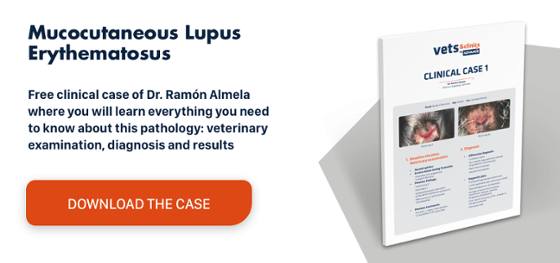Warts in dogs: a review of canine papillomatosis
Introduction to warts in dogs
The word wart is generally used as a lay term for the presence of cutaneous papillomas in dogs. The first indications that warts in dogs could be transmitted date back to the late 19th century, and their viral aetiology was confirmed in 1959.1
Although the vast majority of warts in dogs are caused by canine papillomavirus (CPV), we cannot always assume a viral aetiology.1,2 This is particularly important in palpebral and conjunctival papillomas.3
Aetiopathogenesis of canine papillomavirus
Papillomaviruses are small, non-enveloped, epitheliotropic viruses with double-stranded DNA containing about 8,000 base pairs. They belong to the Papillomaviridae family, which comprises 30 catalogued genera and 18 types of CPV have already been sequenced.1 CPV infects epithelial cells and causes the skin lesions seen in canine viral papillomatosis.Apart from a few exceptions, papillomaviruses are considered species-specific.1,2
CPV is normally transmitted through direct contact, although indirect transmission is possible because it can survive in the environment.1 In order for CPV to establish a persistent infection, it must infect cells that can divide, which in the case of the skin are protected by several layers of keratinocytes. This means the virus requires an injury to the stratum corneum which allows it to reach the stratum germinativum where it multiplies.1,2 However, not all infections cause clinical disease. In fact, most CPV infections are inapparent.1 It seems that the immune system, genetic predisposition and the intrinsic pathogenicity of the specific CPV subtype causing the infection are key to the disease’s evolution. 1,2
Clinical picture
CPV infections can cause different skin lesions, the most significant being oral/cutaneous papillomas and pigmented plaques. In rare cases, CPV has been linked to the development of in situ carcinomas or squamous cell carcinomas (SCCs).1,2
- Canine oral papillomatosis. This is caused by CPV1. It includes the cauliflower-shaped warts typically seen in dogs, but also appears as nodular or “fringed” growths. It mainly affects young or immunosuppressed adult dogs. They can grow in isolation or as massive forms of local infection. They mainly affect the oral cavity but can occasionally be found on the tongue and oesophagus. Protection against future CPV1 infections is thought to be conferred by having had the disease.1 The vast majority of cases resolve spontaneously without any specific treatment.1,2 However, a recent study has documented a series of cases that transformed into SCC.4
- Cutaneous papillomas. These are associated with infections by CPV1, 2, 6 and 7. They mainly affect young animals and usually appear on the face, ears and limbs. Dogs develop single or multiple papillomas and histologically they are classified as exophytic or inverted forms. They usually remit spontaneously but in a colony of immunocompromised dogs cases have been described of inverted papillomas progressing to SCC.1,2
- Pigmented plaques. These are dark, hyperkeratotic lesions, in the form of a flat or, mostly, slightly elevated plaques measuring 1–10 mm in diameter, with multiple plaques usually found on the limbs, axilla and abdomen. In Pugs, the lesions are caused by CPV4, but other breeds are known to be affected by other CPVs, all of which belong to the Chi genus.1,2 CPV3, 9, 15 and 16 have been linked with progression to carcinoma in situ and invasive SCC.5
Diagnosis
The clinical diagnosis is based on the observation of the lesions and epidemiological data, but histopathology and viral particle identification techniques, such as PCR, immunohistochemistry or electron microscopy, are necessary for an accurate diagnosis.1,2
Treatment
Many warts in dogs subside spontaneously in 1–2 months. Otherwise, surgery is used in cases of persistent warts that are problematic for the patient.1,2 However, it should be borne in mind that surgery has been related to latent infections and increased recurrence.2 Treatments with interferon, imiquimod and azithromycin have been recommended, but the corresponding evidence is limited.1 The use of inactivated wart extracts to prevent oral canine papillomatosis has also been suggested.1
Conclusions
Warts in dogs may have different aetiologies, but viral warts should always be taken into consideration. Many CPV infections are subclinical, and spontaneous remission can be expected in a significant percentage of dogs that develop skin lesions. Avoiding immunosuppression may help prevent the disease, but other factors should also be considered.


